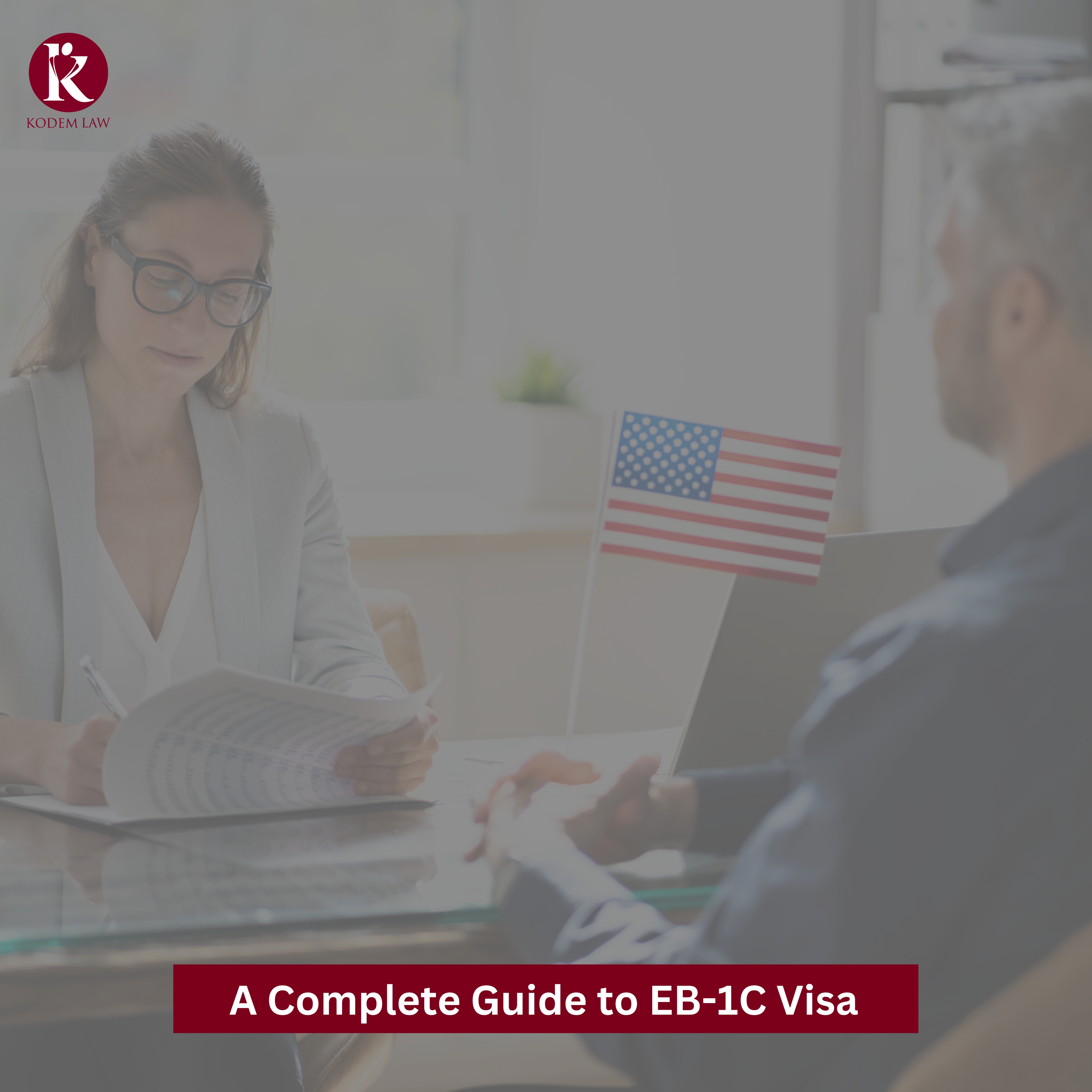
Welcome to our comprehensive guide on the EB-1C visa—a pathway to secure a green card for multinational executives and managers. In this blog, you will understand the key aspects of the EB-1C visa, benefits, eligibility, application process and much more.
What does EB-1C Visa mean?
The EB-1C visa is crafted for executives or managers with multinational experience, employed by the same company abroad for at least one of the past three years, and currently undergoing a transfer to a U.S. office or affiliate. This visa not only facilitates the transition but also serves as the gateway to acquiring the highly sought-after U.S. green card. Widely regarded as an excellent choice for managers and executives seeking to move from a foreign company to a related U.S. entity, the EB-1C visa extends the green card privilege to the foreign worker, their spouse, and unmarried children under 21 years old.
What are EB-1C Visa Requirements?
The EB-1C visa is an excellent green card option for L-1A managers and executives currently in the U.S. under nonimmigrant status. This is primarily because many of the EB-1C requirements align closely with those of the L-1A visa.
1. Employer Requirement for EB-1C Multinational Executives/Managers:
- The employing company must have a qualifying relationship with a foreign company, such as being a parent, subsidiary, or affiliate.
- The employing company must engage in business operations in both the United States and at least one other country, either directly or through a subsidiary.
- The company must have been established for a minimum of one year in the United States.
2. Employee Requirements for EB-1C Multinational Executives/Managers:
- The manager or executive must have been employed outside the United States with the related foreign company for 1 year in the preceding 3 years. The employment must have been in a managerial or executive capacity.
- The chosen U.S. employer must demonstrate a business presence of at least one year and provide proof of the individual’s managerial or executive capacity.
Managers must:
- Manage a specific function or department within the organization.
- Supervise and have the authority to hire and terminate subordinates.
- Control the daily activities and salaries of employees.
Executives must:
- Be able to direct managers within the organization.
- Make substantial decisions independently, without significant supervision.
- Establish comprehensive goals and policies on a large scale.
Note: The EB-1C visa provides a seamless transition for managers and executives seeking permanent residency, recognizing their significant contributions and leadership roles within multinational organizations.
What are the Documents Required for EB-1C Visa?
The documentation process is a crucial step in securing your EB-1C visa. Here are the necessary paperwork which includes proof of employment history, job offer letters, and other supporting documents that strengthen your case.
For Applicant:
- Evidence of Permanent Job Offer from U.S. Employer: Letter or contract confirming the permanent job offer.
- Resume: A comprehensive resume detailing professional experience, skills, and achievements.
- Diploma: Official documentation verifying educational qualifications.
- Confirmation Documentation to Verify the Transfer: Records substantiating the transfer from the foreign company to the U.S. office or affiliate.
- Affirmation of Applicant’s Managerial or Executive Position: A self-affirmation or statement illustrating the applicant’s managerial or executive role.
For U.S. Employers/ Foreign Employers (if applicable)
- Business License: Official documentation demonstrating the legal right to conduct business.
- Incorporation Documents: Legal paperwork confirming the formal establishment of the business.
- Business Plan: A detailed outline of organizational goals, strategies, and operations.
- Organization Charts: Visual representations of the company’s structure and hierarchy.
- Employer’s Quarterly Report (Form 941): Official reports outlining quarterly employment taxes.
- Corporate Income Tax Return (Form 1120): The company’s official federal income tax return.
- Accounting Reports: Audited Balance Sheet, Income Statement, and Cash Flow statements.
- Description and Letterhead of Company Business: A brief overview and official letterhead showcasing the company’s business.
- Pictures of the Main Office, Factories, and Buildings (Outside and Inside): Visual documentation of the company’s facilities.
- Bank Statements: Official records of the company’s financial transactions.
- Organization Structure: A document outlining the roles and responsibilities within the organization.
- Proof of Business Transactions: Records substantiating business activities and transactions.
- Articles of Incorporation: Legal documentation establishing the company as a corporate entity.
- Income Taxes for the Past 3 Years: Official tax filings for the previous three years.
- Lease of Business Location: Agreement confirming the lease of the business premises.
- Stock Certificates: Certificates validating ownership of company stock.
Note: Ensure close collaboration with your immigration attorney to compile and present these documents effectively for a successful EB-1C visa application.
EB-1C Visa Application Process
The Step-by-Step EB-1C Green Card Application Process is as follows:
- I-140 Immigrant Petition Filing: Initiate the process by having your employer file an I-140 immigrant petition for alien workers with the United States Citizenship and Immigration Services (USCIS).
- I-140 Approval: Upon approval of the I-140 petition, you will gain eligibility to proceed with the next steps in the EB-1C green card application process.
- I-485 Application Submission: File an I-485 application to register permanent resident or adjust status. This step is essential for the transition to legal permanent resident status under the EB-1C green card.
- Consular Processing (if outside the U.S.): If you are outside the U.S. during the application, undergo consular processing. Schedule an appointment with the U.S. consulate or embassy in your home country for a one-on-one interview with a consular officer.
-> DS-260 Online Immigrant Visa Application: Complete the DS-260 online immigrant visa application. Bring the printed confirmation page to your consular interview.
-> Consular Interview: Attend the scheduled consular interview. If approved, you can proceed to the next step.
- Legal Permanent Resident Status: Upon approval, your status will change to legal permanent resident. Travel to the U.S. where, after a brief background check, the officer at the U.S. port of entry (border, seaport, or airport) will stamp your passport for entry.
- Receiving EB-1C Green Card: Your EB-1C green card will be mailed to you shortly after you enter into the U.S.
- Biometrics (if applicable): Depending on your age, you may be required to have your biometrics taken. Consult with your immigration attorney to determine if this requirement applies to you.
Benefits of EB-1C Multinational Manager or Executive
No PERM Labor Certification Required:
- Bypasses the labor certification process, expediting the overall application process.
- Facilitates quicker work/travel authorization.
Expedited Process:
- Compared to some EB-2 and EB-3 categories with waiting times of several years, EB-1C offers a more timely application process.
Note: These advantages make the EB-1C Multinational Manager or Executive category an appealing option for those seeking a green card, offering a streamlined pathway without the need for a lengthy labor certification process and ensuring a prompt availability of visa numbers upon I-140 approval.
EB-1C Visa Processing Time
- Nebraska Service Center: Approximately 9.5 months
- Texas Service Center: Around 11 months
- USCIS processing time for Form I-140: Typically ranges from 7 to 13 months
- Premium Processing (additional fee):
- Can expedite I-140 processing to 15 calendar days
- After I-140 approval, processing times for adjustment of status (Form I-485) vary
- Consular processing times for immigrant visa applications filed through U.S. embassies or consulates abroad may also vary
- Factors influencing processing time include caseload, USCIS workload, and any additional administrative processing required.
What are EB-1C Visa Priority Dates?
The priority date for EB-1C (Multinational Executive or Manager) is crucial in the immigration process and holds significant importance for applicants. Here’s a concise overview:
- Visa Queue Placement: The priority date establishes an applicant’s position in the queue for visa allocation within the EB-1C category and country of chargeability.
- Determines Eligibility to Proceed: Applicants must wait until their priority date becomes current, as indicated by the “final action dates” in the monthly Visa Bulletin, before proceeding with the next steps in the immigration process.
- Impact on Application Timing: The priority date directly influences when an applicant can file for adjustment of status or initiate consular processing, impacting the overall timing of the EB-1C visa application.
- Varies Across Categories and Countries: Priority dates differ across visa categories and countries of origin, underscoring the need for applicants to monitor specific final action dates for the EB-1C category and their nationality.
- Essential for Visa Availability: The priority date is a critical factor in determining when a visa becomes available for an applicant, affecting the progression of the EB-1C application through the immigration process.
EB-1C Visa Vs. L-1A Visa: Know the Difference
Feature | EB-1C Immigrant Visa | L-1A Non-Immigrant Visa |
Nature of Visa | Immigrant visa leading to permanent residency (Green Card) | Non-immigrant visa for temporary alien workers |
Petition Sponsorship | Individual basis only | Individual or blanket petition available for companies |
Specialized Knowledge | Not sufficient as the primary qualification | Can qualify based on specialized knowledge for a year |
Transition to Green Card | Direct pathway to green card | Requires a separate green card application process |
Immigrant vs. Non-Immigrant Status | Immigrant status with the intent of permanent residency | Non-immigrant status with a temporary work arrangement |
Consultation Requirement | Essential to consult with an immigration attorney | Recommended to consult an attorney for smoother transition |
How Kodem Law Can Help You?
The EB-1C visa journey can be overwhelming with lots of paperwork and strict rules. Kodem Law is here to help! Our experienced immigration attorneys specialize in guiding you through the entire process, making it simpler and successful. We’ll help you gather all the necessary documents and provide personalized advice to make your application stand out. With Kodem Law, you get expert guidance, thorough document assistance, strategic advice for success, and regular updates to keep you informed. Choosing us means choosing a dedicated partner to make your EB-1C visa journey smoother, bringing you closer to getting a U.S. green card. Contact us today to start this journey with confidence and assurance.

